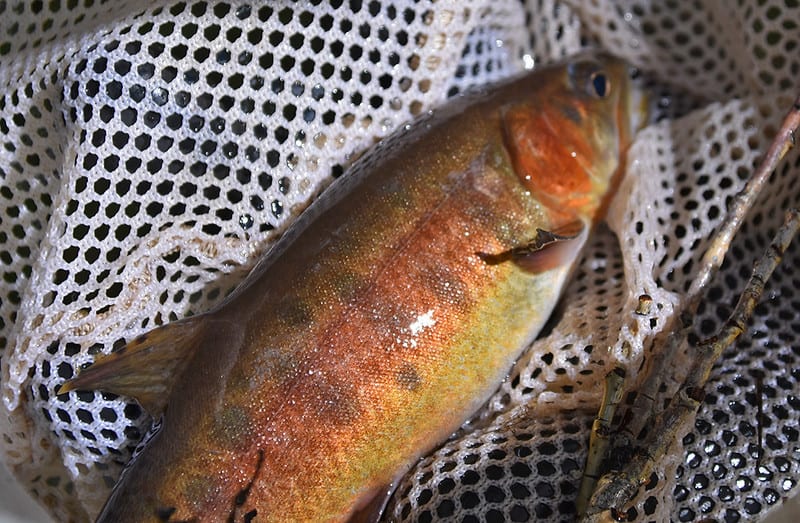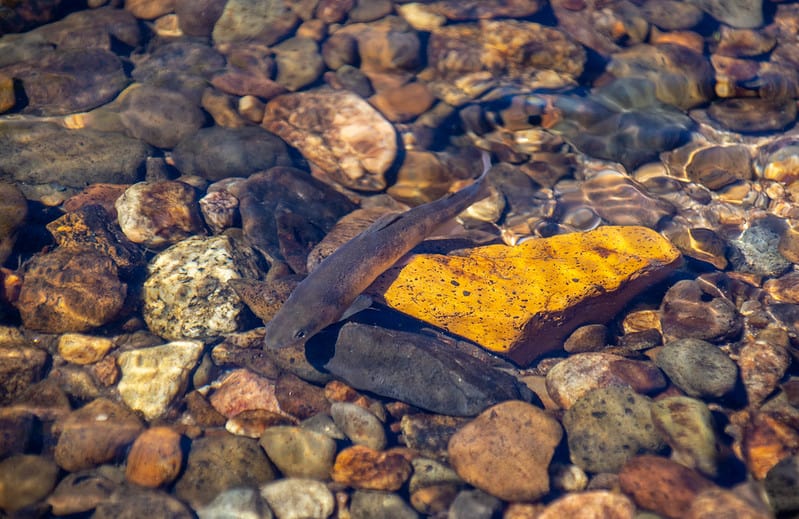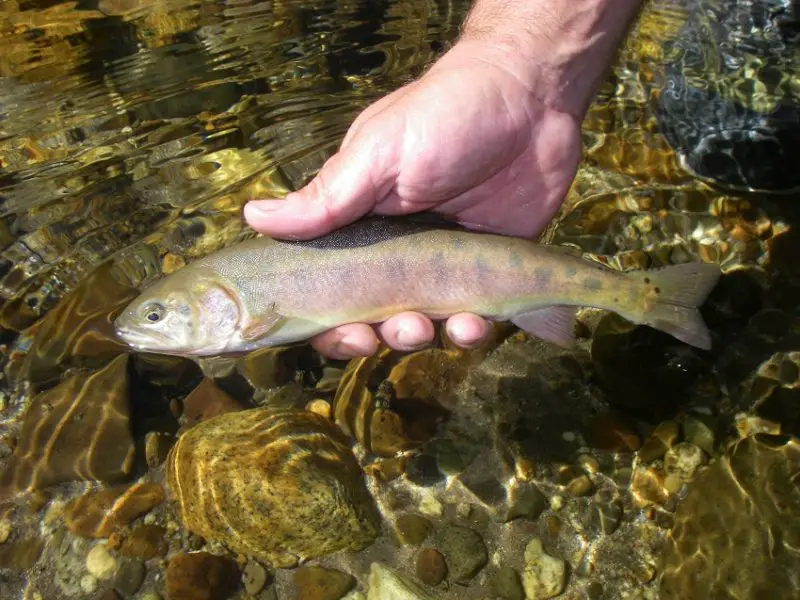Paiute Cutthroat trout, “Oncorhynchus clarki seleniris”, are the rarest trout species in the world. Their home range is very small, and it is being encroached upon by nonnative trout species. To make matters worse, their species is under constant threat of being hybridized out of existence. Consequently, they were one of the first animals in the nation to be listed as Endangered in 1967 under the Federal Endangered Species Act.
They originate from a small tributary of the East Carson River in the Carson-iceberg wilderness, in Alpine County, on the eastern slope of the Sierra Nevada range in the state of California. They are the descendants of a geographically isolated group of parent stock.
According to a hypothesis proffered in the book “Trout and Salmon of North America” by Robert J Benke, they descend from a group of Carson River Lahontan Cutthroat trout. These fish became isolated in the Silver King Creek drainage a couple of thousand years ago.
According to the California Department of Fish, the historic range of Paiute cutthroat trout consisted of an 11-mile stretch of silver king creek and its tributaries, Corral Valley Creek and Coyote Valley Creek. It ran from a steep canyon which created a natural barrier to fish moving in from downstream to Llewellyn falls, which presented a natural barrier to fish movement on the upstream side.

Paiute Cutthroat Trout Description
The characteristic that makes Paiute cutthroat trout unique is the lack of body spots. Other trout species have numerous dark spots on their bodies, as well as their tail, caudal, and dorsal fins. Paiute cutthroat trout do not. However, they may have a handful of spots on their caudal and dorsal fins.
Paiute cutthroat trout are iridescent fish. The shade of their coloration shifts from greenish-brown on their backs to pale yellow on their bellies. They have a crimson lateral line along their side that is overlaid with vertical purple parr marks.
From Benke, Paiute cutthroat trout size is highly influenced by the quality of their environment as well as their genetics. These fish primarily live in small streams at high elevations with a scarcity of available nutrients. On average, adults are 6 to 10 inches (15 to 25 cm) long. In stream environments, if they live long enough, they might grow to a maximum size of 12 inches (30 cms) long and weigh up to 11 ounces (312 grams).
In lake environments, these same fish can get up to 18 inches (46 cms ) long and weigh up to 2 pounds and 8 ounces (1.1 kg)
Transplantations of Paiute Cutthroat Trout
There are several occasions when people transplanted these fish beyond their native range. These fortunate occurrences are the only thing that has saved pure Paiute cutthroat trout from becoming extinct. They provided and continue to provide source populations to draw from in restoring a pure population of Paiute cutthroat trout to their native range
In about 1912, Joe Jaunsaras who was taking care of sheep in the area, transplanted Paiute cutthroat trout in a coffee can above Llewellyn falls. This started a new population of fish and gave them access to a few additional miles of stream.
Again, according to Salmon and Trout of North America, at some unknown time, someone, possibly Basque sheepherders, transplanted Paiute cutthroat Trout above the falls in Corral Valley and Coyote valley creeks. This established two new populations.
Additionally, in 1946 the California Department of Fish and Wildlife transplanted genetically pure Paiute cutthroat trout into the North Fork of Cottonwood Creek. Cottonwood Creek isn’t located in the silver king creek basin. It’s located in the White Mountains which are across the Owens Valley from the Sierras in Mono County.
Some other creeks outside the Silver King Creek watershed where Paiute Cutthroat trout have been transplanted over the last century are Cabin Creek, Sharktooth Creek, and Stairway Creek. Each of these now have self-sustaining populations of Paiute Cutthroat Trout that are located outside of the silver king drainage. Ergo, these streams are located in Mono County, Fresno County, and Madera County, respectively.
Hybridization Of the Native Paiute Populations
There’s a real possibility that pure Paiute trout will be hybridized out of existence. That’s the greatest threat to the long-term survival of their species.
In the early 1900s, the California Department of Fish and Wildlife spent a lot of time and resources transplanting nonnative Trout around the state via pack train. This was a helpful, productive practice when they moved fish into waters that had previously been fishless. However, they also stocked Rainbow trout, Brook trout, and Brown trout into streams that already had populations of native trout, to devastating effect. The stocked Rainbows immediately begin hybridizing with the native trout. Additionally, the more aggressive Browns and Brookies outcompete them for territory and resources
By 1933 pure Paiute cutthroat trout only remained in the transplant areas. The fish in their original home range were all hybridized with nonnative Rainbow trout.
In around 1949, the California Department of Fish and Wildlife accidentally introduced Rainbow Trout into upper Silver King, Coyote Valley, and Corral Valley Creeks. At the time, they knew that these creeks held pure Paiute Cutthroat Trout. However, a pack string carrying rainbow trout fry took a wrong turn on the trail and stocked rainbow trout into these creeks along the way.
About ten years another accidental stocking of nonnative trout happened. This time, they accidentally aerially stocked Lahontan cutthroat trout into a lake headwater of Silver King Creek.
According to Benke, by 1964, the Paiute Cutthroat Trout in Silver King, Corral Valley, and Coyote Valley creeks were all hybrids.

Paiute Cutthroat Trout Restoration Project
Rainbow Trout, California Golden Trout, Paiute Cutthroat, Brook Trout, and Lahontan Cutthroat Trout have all been stocked in the Silver King Basin. Paiute Cutthroat Trout cannot compete with these invasive species. Rainbow Trout, California Golden Trout, and Lahontan Cutthroat Trout all readily crossbreed with Paiute Cutthroat Trout. On the other hand, Brook Trout outcompete them for resources and space.
Consequentially, for any restoration work to be successful, one of the first things that need to take place is for all nonnative trout to be removed from their home range.
First, they used chemical treatment to get rid of the nonnative fish. In the years, 2013 through 2015, the California Department of Fish and Wildlife treated the stretch of Silver King Creek from Llewellyn falls downstream to Snodgrass creek with rotenone. Rotenone is a piscicide. It is made from the roots and or stems of several different plants that are residents of the tropics and sub-tropics. The EPA has concluded that rotenone does not pose a significant risk to the environment and quickly dissipates after its application.
After the phase of chemical treatment, the California Department of Fish and Wildlife and the U.S Fish and Wildlife Service wanted to be sure that it was successful. Consequently, they conducted a 3-year observation phase on the treated area of Silver King Creek.
After they determined that the chemical treatment had been a success, the CDFW and its partners began reintroducing Paiute Cutthroat trout into Silver King Creek.
When their restoration efforts are complete, the CDFW anticipates that they will open a section of Silver King Creek to catch and release fishing for Paiute Cutthroat Trout.
Recent Posts
The only venomous snakes in Washington State are Northern Pacific Rattlesnakes. The Northern Pacific Rattlesnake (Crotalus oreganus oreganus) is a sub-species of the Western Rattlesnake. Anyone...
Skunks are not classified as true hibernators. But they go into a state of torpor when the weather gets cold. Skunks are light sleep hibernators, along with opossums, bears, and raccoons. ...

